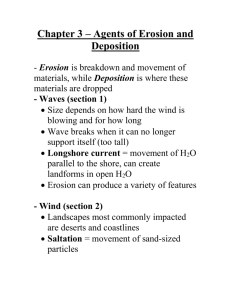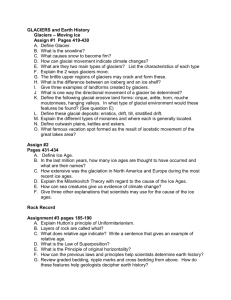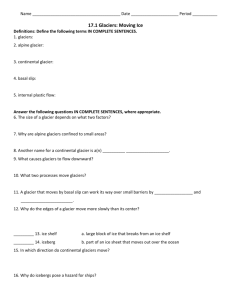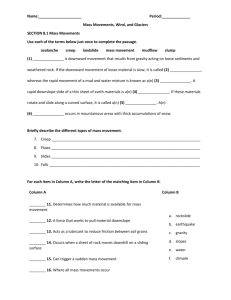Section 3 Erosion and Deposition by Ice
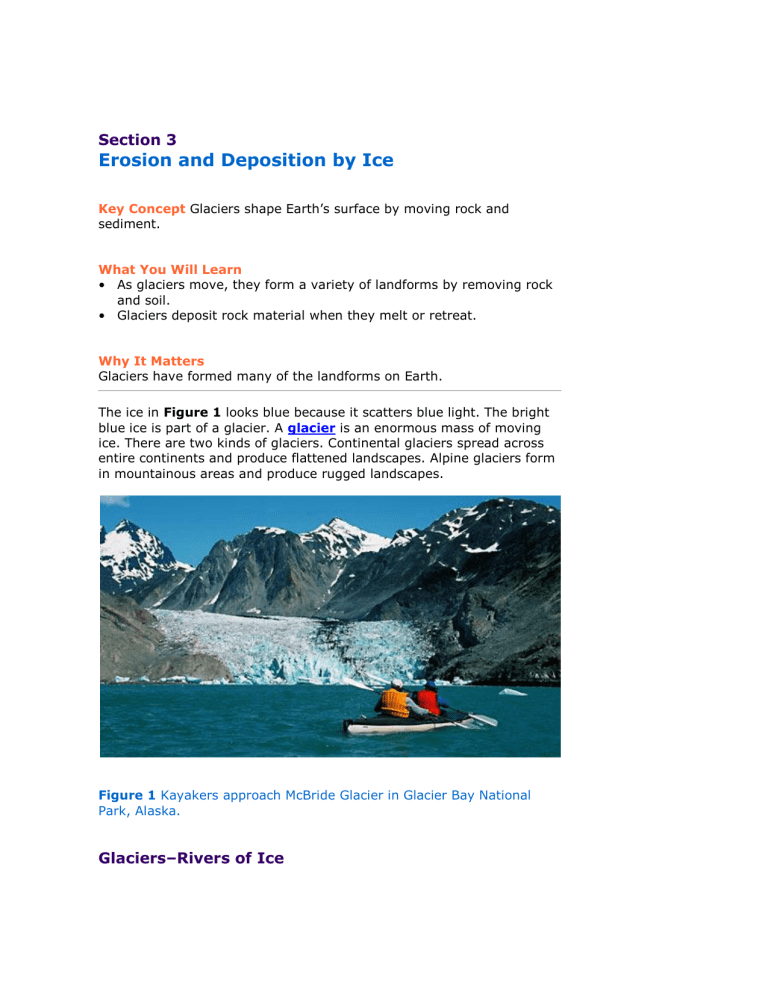
Section 3
Erosion and Deposition by Ice
Key Concept Glaciers shape Earth’s surface by moving rock and sediment.
What You Will Learn
• As glaciers move, they form a variety of landforms by removing rock and soil.
• Glaciers deposit rock material when they melt or retreat.
Why It Matters
Glaciers have formed many of the landforms on Earth.
The ice in Figure 1 looks blue because it scatters blue light. The bright blue ice is part of a glacier. A glacier is an enormous mass of moving ice. There are two kinds of glaciers. Continental glaciers spread across entire continents and produce flattened landscapes. Alpine glaciers form in mountainous areas and produce rugged landscapes.
Figure 1 Kayakers approach McBride Glacier in Glacier Bay National
Park, Alaska.
Glaciers–Rivers of Ice
Glaciers form in areas that are so cold that snow stays on the ground year-round. In polar regions and at high elevations, layers of snow build up year after year. Over time, the weight of the top layers compresses and packs the lower layers. These layers eventually become ice.
How Glaciers Move
Because glaciers are massive, gravity causes glaciers to flow—though slowly—like “rivers of ice.” When enough ice builds up on a slope, the ice begins to move downhill. Thick glaciers move faster than thin glaciers do. The steeper the slope is, the faster the glaciers move. Glaciers move by sliding and by flowing.
How are glaciers an example of water shaping a landscape?
Landforms Created by Glaciers
Glaciers can produce a variety of landforms as they erode the rocks around them. As a glacier moves, rocks below and beside the glacier are broken and moved. Grooves may form in the rock over which the glacier slides as rocks are dragged beneath the glacier.
Figure 2 shows the kinds of landscape features that are sculpted by alpine glaciers.
Figure 2 Landscape Features Carved by Alpine Glaciers
Types of Glacial Deposits
As a glacier melts, it drops all of the material that it is carrying. Glacial drift is the general term used to describe all material carried and deposited by glaciers. Glacial drift is divided into two major kinds, till and stratified drift.
Till Deposits
Unsorted rock material that is deposited directly by the ice when it melts is called till . Unsorted means that the till is made up of rock material of different sizes—from large boulders to fine sediment. When the glacier melts, the unsorted material is deposited on the surface of the ground.
The most common till deposits are moraines.
Moraines generally form ridges along the edges of glaciers. Moraines form when glaciers carry material to the front of and along the sides of the ice. As the ice melts, the glacier drops the sediment and rock that it is carrying. This dropped material forms different kinds of moraines. The different kinds of moraines are shown in Figure 3.
Figure 3 Types of Moraines
Stratified Drift
When a glacier melts, streams that carry rock material away from the shrinking glacier form. A glacial deposit that is sorted into layers based on the size of the rock material is called stratified drift .
Streams carry sorted material and deposit it in front of the glacier in a broad area
called an outwash plain.
Sometimes, a block of ice is left in the outwash plain when a glacier retreats. As the ice melts, sediment builds up around the block of ice, and a depression called a kettle forms. Kettles commonly fill with water to form lakes or ponds, such as the lakes shown in Figure 4.
Figure 4 Kettle lakes form in outwash plains and are common in states such as Minnesota.
How is glacial drift related to glaciers reshaping landscapes?
Section Summary
• Glaciers are masses of moving ice that shape the landscape by eroding and depositing material.
• Glaciers move by sliding or by flowing.
• Alpine glaciers can carve cirques, arêtes, horns, U-shaped valleys, and hanging valleys.
• Two types of glacial deposits are till and stratified drift.
• Deposition of sediment by glaciers can form several landforms, including kettles.

